You are viewing an old version of this page. View the current version.
Compare with Current View Page History
« Previous Version 29 Next »
https://help.myob.com/wiki/x/sYa8Ag
How satisfied are you with our online help?*
Just these help pages, not phone support or the product itself
Why did you give this rating?
Anything else you want to tell us about the help?
When working on a client’s MYOB Essentials file, you may come across some transactions that you can’t allocate until you get more information about them.
To help with this, you can generate a report straight from MYOB Practice that lists all unallocated transactions for a date range, so you can get your client to fill in the gaps.

And to save more time, you can create coding reports for several clients in one go, without needing to open each MYOB Essentials file.
Coding reports can be created for MYOB Essentials files only.
How the reports will be delivered
For clients with portals, you can choose to send a coding report task to the bulk task assignees specified in each portal. If bulk task assignees are not specified, the task will be assigned to all full access users.
You set up the delivery preference in each client’s settings.
You can only create a task for a client if:
- you’ve created a client record for them in MYOB Practice
- have linked the client to their MYOB Essentials file
- the client has access to a portal.
For clients without portal access, we can email your client a link to download their reports, or we can email them to you, and you can then email them manually, or print and mail them out.
- Log into MYOB Practice and open the Transaction processing page.
Select the MYOB Essentials files you want to create coding reports for, by clicking the checkboxes next to the file and client names.
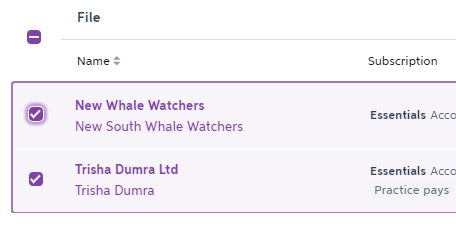
If you've set up coding report frequencies for the clients, you can filter the Transaction processing page to show just those who have a report due. Learn more
- Click Generate coding report.

- Select the transaction date range you want to include in the report.
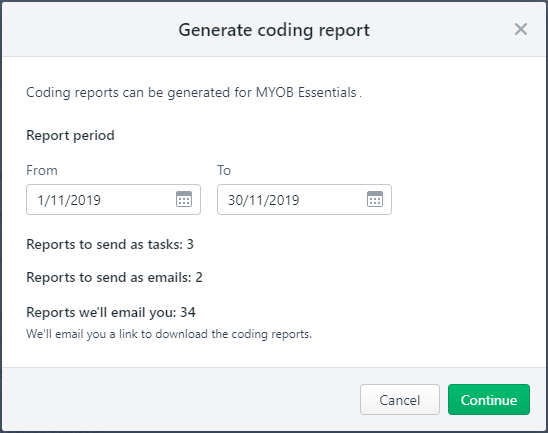
- The summary window tells you how many of the files you selected will be sent to clients with access to a portal, and how many will be emailed to your clients or to you. If you haven’t specified delivery preferences for a client, we’ll email you a link to download their reports.
- Click Continue.
- If you haven't set up report format preferences for one or more of the selected clients, you'll need to select the report format to use for them (for the others the formats you've already defined for each client will be applied automatically).
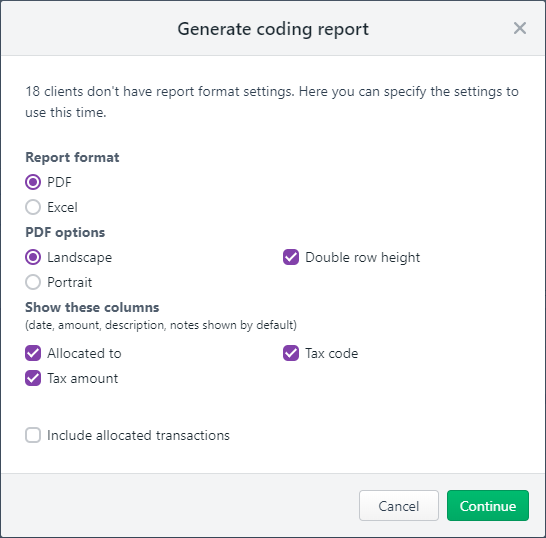
- If the report will be printed, we suggest using the PDF format.
If you select PDF, you can:- select the page orientation, either Portrait or Landscape.
- give your clients more room to write their notes in, by selecting the Double row height option.
Select if you want to add the optional columns. For example, if you’ve added notes or questions in the transaction in MYOB Essentials that you want the client to review, select the Notes column.
If you're generating a PDF with the portrait orientation, you can only show/hide the Allocated to column.
- Select if you want to include allocated transactions in the report. This might be useful if you’ve entered notes against allocated transactions in MYOB Essentials that you need further information or source documents for.
- Click Continue.
- If the report will be printed, we suggest using the PDF format.
- If you’re sending reports to client portals or emailing reports directly to clients, the Coding report notification window appears.
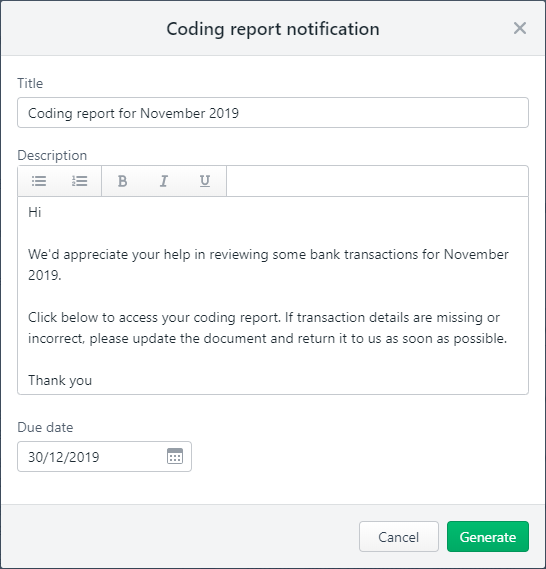
Enter a title. This will be the subject line of the email notification all clients will receive, and for tasks, the title of the task in the portal.
Enter a description. This will appear in the email notification for all clients, and for tasks, will be part of the task details.
(Optional, tasks only) Enter a due date if you want your clients to review the coding report by a certain date.
Click Generate.
We’ll start sending the emails and if applicable, coding report tasks for your clients to review in their portals. This can take a few minutes to complete, and you’ll receive an email to confirm what we’ll be sending.
- If you’ve selected to receive client reports by email, you’ll receive an email when their reports are ready to download.
- When you receive the email, click Download your coding reports in the email, and a zip file containing the reports will start downloading.
If you’re not logged in to MYOB Practice, you’ll need to log in before you can download the zip file. If you have access to multiple practices, make sure you log in to the relevant practice. - After the zip file has finished downloading, open or unzip/extract it to view the coding reports it contains.
In the example below, the zip file was downloaded using the Chrome browser on a PC. Choose Open to access the reports that are in the zip file. To find the zip file on your computer, choose Show in folder.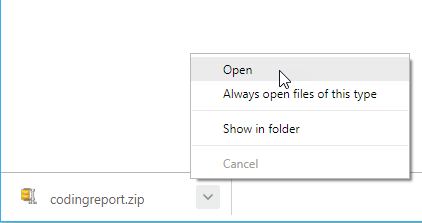
- When you receive the email, click Download your coding reports in the email, and a zip file containing the reports will start downloading.

 Yes
Yes
 No
No
 Thanks for your feedback.
Thanks for your feedback.